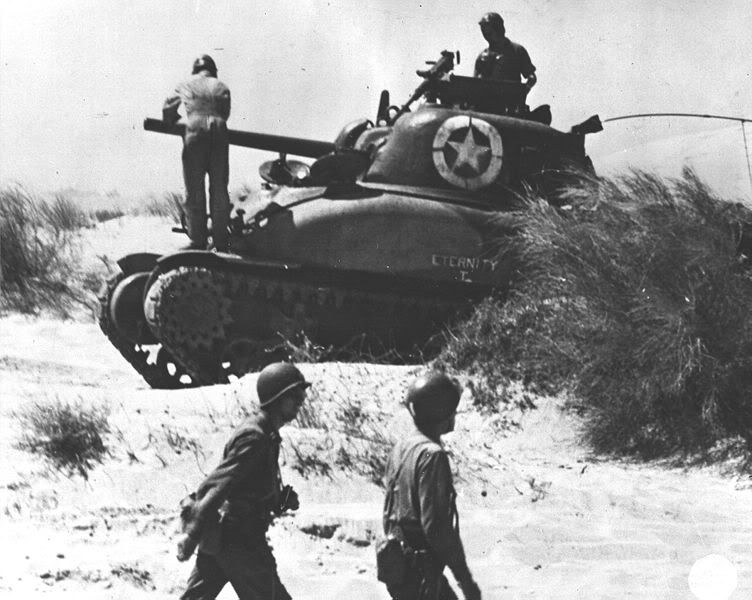
This photo, taken in Africa shortly after the United States joined the Allies in World War II, shows an American tank crewman teaching his British counterparts about the new American tanks. While on the surface it seems to be a simple classroom picture, the various technical and emotional aspects of this photo show the enthusiasm of the soldiers, and the importance of the occasion.
The first thing most people will notice when they look at this picture are the vectors of attention. With the exception of the man farthest away from the camera (which we will discuss in a moment), none of the soldiers are looking at the camera. This only makes sense, since the American is teaching the six British tank crewman. What is unexpected, however, is the American’s vector of attention. We might expect it to be looking at his “students,” or at the tank. Instead, he is looking at the shell he is holding. The appeals to logos, pathos and ethos shine through. The photographer is attempting to give us a general ethos of an objective observer. The enthusiasm of the Britains toward the new tank and the enthusiasm of the American for the ammunition give an ethos of expectation. At this point in time, after all, the American tanks were thought to be the best in the world. It seems as though the American is saying, “Now we’ll get ‘em.” Meanwhile, the man farthest from the camera looks directly at the audience. It appears he does not share his comrades’ enthusiasm and is telling the audience, “Remember this; it will change the world.” This, of course, is an appeal to logos. There are more appeals in the vectors of attention, but time dictates that I move on.
Whether intentional or not, the focus of this picture, achieved mainly through lighting and coloration, in not actually foreground. The focus is instead the tank. This could be accidental, since the picture was taken in black and white (which the technology of the day dictated), and the picture was taken in the North African desert. Regardless of the intentionality of the focus, it seems to make the argument that the important thing in modern warfare is not the soldier, but the machinery. It actually took me a little while to notice the teacher at all. He blends into the tank behind him, highlighting the anonymity of modern warfare.
As I stated before, I believe much of the coloration, hue, and lighting of the picture are not meant to make an argument but are instead reflections of period technology and weather. The framing is intentionally simple to avoid the viewer getting distracted from the picture itself.
This picture, while simple in its design and execution, elicits feelings of hope, expectation, and given our historical perspective, a certain measure of despair. The logos, pathos, and ethos of the photo add to that effect. The lighting, coloration, etc, while maybe not intentional, certainly adds to the emotional reaction the viewer feels. World War II was the most dramatic war in history, and this picture gives us a little glimpse of that drama.
The first thing most people will notice when they look at this picture are the vectors of attention. With the exception of the man farthest away from the camera (which we will discuss in a moment), none of the soldiers are looking at the camera. This only makes sense, since the American is teaching the six British tank crewman. What is unexpected, however, is the American’s vector of attention. We might expect it to be looking at his “students,” or at the tank. Instead, he is looking at the shell he is holding. The appeals to logos, pathos and ethos shine through. The photographer is attempting to give us a general ethos of an objective observer. The enthusiasm of the Britains toward the new tank and the enthusiasm of the American for the ammunition give an ethos of expectation. At this point in time, after all, the American tanks were thought to be the best in the world. It seems as though the American is saying, “Now we’ll get ‘em.” Meanwhile, the man farthest from the camera looks directly at the audience. It appears he does not share his comrades’ enthusiasm and is telling the audience, “Remember this; it will change the world.” This, of course, is an appeal to logos. There are more appeals in the vectors of attention, but time dictates that I move on.
Whether intentional or not, the focus of this picture, achieved mainly through lighting and coloration, in not actually foreground. The focus is instead the tank. This could be accidental, since the picture was taken in black and white (which the technology of the day dictated), and the picture was taken in the North African desert. Regardless of the intentionality of the focus, it seems to make the argument that the important thing in modern warfare is not the soldier, but the machinery. It actually took me a little while to notice the teacher at all. He blends into the tank behind him, highlighting the anonymity of modern warfare.
As I stated before, I believe much of the coloration, hue, and lighting of the picture are not meant to make an argument but are instead reflections of period technology and weather. The framing is intentionally simple to avoid the viewer getting distracted from the picture itself.
This picture, while simple in its design and execution, elicits feelings of hope, expectation, and given our historical perspective, a certain measure of despair. The logos, pathos, and ethos of the photo add to that effect. The lighting, coloration, etc, while maybe not intentional, certainly adds to the emotional reaction the viewer feels. World War II was the most dramatic war in history, and this picture gives us a little glimpse of that drama.
No comments:
Post a Comment